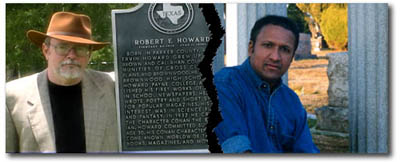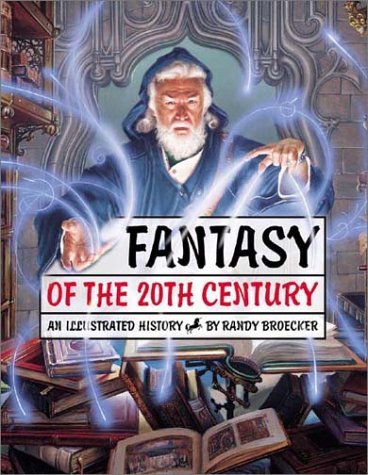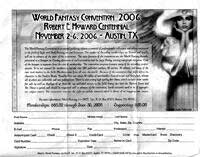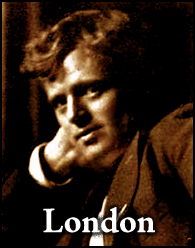Incidentally, Era Lee Hanke, President of Project Pride in Cross Plains, had a hand in popularizing the event this year, not only getting a commercial on television played sixty times in the lead-up to the weekend, but also getting coverage in local papers, including helping attract the Bulletin, urging the paper to write the articles. Howard has had few friends in the last few years as dogged, inventive, and worthy of praise as Era Lee. However, Era Lee gets it all wrong when she states that Howard fans “don’t come here to see us. They come here to see each other.” I for one look forward to seeing the ladies of Project Pride each and every year, as much if not more than seeing the Howard marvels the town offers. One of the greatest things about Howard Days is all the new friends I otherwise would never have met.
CROSS PLAINS ROLLS OUT RED CARPET FOR ROBERT E. HOWARD DAYS
By Gene Deason
Thursday, June 9, 2005
Brownwood Bulletin
CROSS PLAINS — The legacy of fantasy writer Robert E. Howard will be celebrated this weekend as Cross Plains hosts visitors from around the world for tours, auctions and programs.
Marcelo Anciano of London, with Wandering Star, publisher of the Robert E. Howard Library of Classics, will be attending this year’s events Friday and Saturday. He will speak on “Let His Name Not Fade: Interpreting Robert E. Howard in Books, Films and Other Media” at a banquet Friday night and participate in a panel discussion with other Howard scholars Saturday afternoon.
“Brownwood is very tied to this event,” said Era Lee Hanke, president of Project Pride, the Cross Plains organization which owns the Robert E. Howard House and Museum and hosts the annual event. “Bob Howard attended his final year of high school at Brownwood. We have a 1923 Brownwood High yearbook with his picture in it. And then he took some classes at Howard Payne. He is buried in Greenleaf Cemetery.”
Many of those attending from outside the immediate area will also be staying in Brownwood, she said. More than 200 guests are expected, including 90 who have made reservations for the casual banquet at 7 p.m. Friday.
“This is quite a thing for Cross Plains,” Hanke said. “We have people come and have their pictures taken at the Howard house. They say ‘Bob Howard actually stood at this spot.’ Word has really spread about this event, and interest has really taken off in the last few years.”
Howard is best known for his creation of the literary genre known as “Sword-and-Sorcery,” featuring Conan. His fantasy fiction character came to the attention of the general public when the movie “Conan the Barbarian” starring a youthful bodybuilder named Arnold Schwarzenegger took the box office by storm in 1982.
“Howard also wrote quite a bit of other types of literature,” Hanke added. Those include historical adventure, suspense, detective stories, gothic horror, sea stories and Western burlesque.
Howard, born in 1906 in Palo Pinto County, was the only son of Dr. and Mrs. Isaac M. Howard. The family lived in several different Texas communities—including Cross Cut in Brown County—but by 1919, they had settled in Cross Plains. Most of Howard’s writing was done in their home on West Highway 36, a building which is listed on the National Register of Historic Places and has been restored by Project Pride as a museum. He died in 1936 of a self-inflicted gunshot as his mother faced his own death because of illness.
The public is invited to attend a variety of events scheduled Friday and Saturday, including tours of the Howard home and panel discussions on his work. The pavilion on the museum grounds will serve as a headquarters for visitation by those attending, and a variety of Howard books—including new volumes published by the University of Nebraska Press—will be available for purchase.
“They don’t come here to see us,” Hanke said of the guests arriving from long distances. “The come here to see each other.”
A special postal cancellation noting the occasion will be available at the Cross Plains Post Office Saturday morning.
Anciano, the featured speaker at Friday night’s casual banquet, has been a promoter for the rock group Duran Duran, and director and producer of music videos and feature films. He has been publisher of the Robert E. Howard Library of Classics for eight years. Tickets to the dinner were sold in advance.
On Friday, tours of the Howard home will be available from 9 a.m. until 4 p.m. A walking tour of the Cross Plains Cemetery is set from 10 to 11 a.m., and lunch will be served at the pavilion from 11:30 a.m. to 12:30 p.m. with donations as the cost of the meal. Bus tours will be offered from 12:30 to 2 p.m. from the pavilion, and the Cross Plains Library will feature a collection of Howard items from 1 to 5 p.m.
Paul Herman will lead a program on caring for a Howard collection from 2:30 to 3 p.m. Friday at the pavilion, and a book-signing is set from 3 to 4 p.m. Rusty Burke and [redacted] will offer a seminar from 4 to 5 p.m. at the pavilion on writing a Howard biography. The banquet is set for 7 p.m. at the community center.
On Saturday, the stamp cancellation is set from 8 to 10 a.m. at the post office, and the Howard house will be open for tours from 9 to 11:30 a.m., and again from 2 to 4 p.m. The Barbarian Festival will be under way on Main Street from 9 a.m. until 5 p.m., and a screening of “Pigeons from Hell” with commentary by Burke, Anciano and Michael Scott Myers is set from 10 to 11:30 a.m. at the high school.
Bus tours will leave from the pavilion at 12:30 p.m. Howard items will again be shown at the library from 1 to 3 p.m. Bill Cavalier and James Reasoner will speak on “What Would Robert E. Howard Have Done Had He Lived” from 2 to 2:30 p.m.
A Wandering Star panel featuring Anciano, Burke, and Jim Keegan is planned at the pavilion from 3 to 4:30 p.m. The Saturday evening meal will be at Caddo Peak Ranch, and those attending will meet at the pavilion at 5 p.m.
A group of about 10 people are involved in Project Pride throughout the year, but Howard Days requires as many as 40 volunteers, Hanke said.
FANS: ROBERT E. HOWARD HAD MANY WORLDS TO CONQUER IF HE HAD LIVED
By Gene Deason
Monday June 13, 2005
Brownwood Bulletin
CROSS PLAINS — Fans and experts alike agreed Saturday that Robert E. Howard, the Cross Plains fantasy writer who took his own life at the age of 30, would have become a giant in his field if he had lived. The question, though, is exactly what field that might have been.
“That’s what I love about Robert E. Howard speculation,” artist and long-time Howard enthusiast Bill Cavalier said during a panel discussion on what Cross Plains’ most famous resident might have done. The program was one of several panel discussions held Friday and Saturday during Robert E. Howard Days, an annual celebration of his works which draws international attention.
Howard is best known today for establishing the fantasy fiction genre, which was headlined by the character Conan who was brought to life on the movie screen by Arnold Schwarzenegger in the early 1980s. But by the time of his death in 1936, Howard had left that part of his career behind and was moving into other types of
literature.
Parallels between Howard’s writing and his Conan character, and Edgar Rice Burroughs’ career and his Tarzan character, were raised in an attempt to project what direction Howard’s career might have taken. Burroughs, while 25 years his senior, was also a pulp fiction story writer who developed into an international celebrity. However, author James Reasoner, the other member of the panel, was not confident that Conan would made a similar leap into other literary forms as Tarzan did. It wasn’t Howard’s style.
“The only thing that makes me think that is, Howard tended to leave his characters behind,” Reasoner said. “That was his professional history, and he was talking about writing westerns primarily.”
That raised speculation that his interest in movies might have taken him into a career as a script writer for films.
“I would have to think with Howard’s great love for the movies, it would be a natural progression,” Cavalier said.
He noted that western movies in the 1930s are considered poor, and that Howard’s death came three years before the release of what is considered the first great western, John Ford’s Stagecoach. That evolution could have been what it would have taken to turn Howard in that direction.’ Based on mutual acquaintances, it is probable that Howard would have teamed with Ford.
Reasoner said Howard’s approximately 100 articles, published primarily in pulp magazines of the era, were basically styled in a form of a movie script.
“You don’t find page after page of what a character is thinking,” Reasoner said. “His work is very external. That’s what a film is. He was one of those writers who expects the reader to meet him halfway, and that’s what a movie does.”
Reasoner agreed that Howard had a great future as a western writer.
“He would have been a big name in the western genre had he lived,” he said. “He was writing westerns. He was just five or six years ahead of his time. All he had to do was walk out his back door, and there was the West.”
Cavalier said there is also evidence to support those who think Howard may have become a great novelist.
“Later in his career, his stories got longer,” he said.
Howard had also expressed delight with the vast number of stories available to him as a pure fiction writer, and comparisons to Mickey Spillane’s gritty prose were offered. However, Reasoner said Howard had shown no interest in detective stories.
Members of the audience wondered if he might have become a battlefield correspondent in World War II, as a few pulp writers did. His interest in international affairs had been documented; in the 1920s, he wrote in letters in which he expressed worries about Japan and his hatred of Adolph Hitler.
One person suggested he probably would have traveled extensively if he had lived past his mother’s death. There would be nothing holding him from leaving Cross Plains.
Questions arose concerning Howard’s mental state during the final days of his life, before he took his own life on June 11, 1936.
“Was this something that was inevitable, or was it just a bad time in his life?” a member of the audience asked, alluding to the bouts of depression many highly creative people often battle.
Most seemed to think his suicide was the result of several personal setbacks which occurred at the same time. The consensus was that Howard would have been able to deal with them if they had not all hit him at the same time—the fatal illness of his mother, who died the day after he took his life, along with the break-up with his girlfriend and difficulties in his work.
“If any of those other things hadn’t been happening, he might have survived,” Reasoner said.
Reasoner marveled at Howard’s grasp of the publishing business and the richness of his stories, which would have been a key to major success in later years.
“For somebody who was stuck out in a small town in Texas, he knew his markets and he knew his editors,” Reasoner said. “No matter how long he lived, I think he would have continued doing very well.”
“It’s a never-ending debate,” Cavalier observed of the speculation. “He died at such an early age when his career was just about to take off. In the 12 years he worked, he wrote some good things, and he wrote some bad things. What direction would he have gone? He liked writing history, and he was getting away from fantasy. He wrote in 1933 that he might live the rest of his life writing history in the guise of fiction.”
“He wrote that he wished he had a century to write historical fiction,” he said. “He wrote a lot about history in everything he did. If he didn’t have any history, he made it up.”
“He was just on the verge of making the big time,” Cavalier observed. “It’s such a shame he had to leave us.”
Also participating in the discussion from the audience were Rusty Burke; prominent Howard researcher and author, and Michael Scott Myers, who co-produced and wrote the screenplay of the 1996 movie The Whole Wide World.
The film is based on the book One Who Walked Alone: Robert E. Howard, The Final Years by Novalyne Price Ellis, a memoir of Howard’s final two years from the eyes of his girlfriend. The film stars Renée Zellweger and Vincent D’Onofrio.







